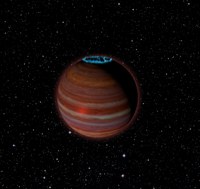Spotting a Rogue, Giant Magnetized Planet
 Characterizing magnetic fields in the coolest dwarfs and eventually exoplanets can provide valuable insight into the formation, emission, and evolution of planets through stars. Kao et al. used the Karl G. Jansky Very Large Array to observe a sample of five known radio-emitting late-L and T dwarfs ranging in age from ∼0.2 to 3.4 Gigayears (Gyr). Each target was observed for seven hours, extending to higher frequencies than previously attempted and establishing proportionally higher limits on maximum surface magnetic field strengths. Detections of circularly polarized pulses at 8–12 GHz yield measurements of 3.2–4.1kG localized magnetic fields on four targets, including the archetypal cloud variable and likely planetary-mass object T2.5 dwarf SIMP J01365663+0933473. A pulse at 15–16.5 GHz was also detected for the T6.5 dwarf 2MASS 10475385 +2124234, corresponding to a localized 5.6 kG field strength. For the same object, a 16.5–18 GHz pulse was tentatively detected, corresponding to a localized 6.2 kG field strength. Rotation periods were measured between ∼1.47 – 2.28 hours for 2MASS J10430758+2225236, 2MASS J12373919+6526148, and SDSS J04234858–0414035, supporting: (a) an emerging consensus that rapid rotation may be important for producing strong dipole fields in convective dynamos; and/or (b) rapid rotation is a key ingredient for driving the current systems powering auroral radio emission. The authors observe evidence of variable structure in the frequency-dependent time series of our targets on timescales shorter than a rotation period, suggesting a higher degree of variability in the current systems near the surfaces of brown dwarfs. Age, mass, and temperature together cannot account for the strong magnetic fields produced by our targets.
Characterizing magnetic fields in the coolest dwarfs and eventually exoplanets can provide valuable insight into the formation, emission, and evolution of planets through stars. Kao et al. used the Karl G. Jansky Very Large Array to observe a sample of five known radio-emitting late-L and T dwarfs ranging in age from ∼0.2 to 3.4 Gigayears (Gyr). Each target was observed for seven hours, extending to higher frequencies than previously attempted and establishing proportionally higher limits on maximum surface magnetic field strengths. Detections of circularly polarized pulses at 8–12 GHz yield measurements of 3.2–4.1kG localized magnetic fields on four targets, including the archetypal cloud variable and likely planetary-mass object T2.5 dwarf SIMP J01365663+0933473. A pulse at 15–16.5 GHz was also detected for the T6.5 dwarf 2MASS 10475385 +2124234, corresponding to a localized 5.6 kG field strength. For the same object, a 16.5–18 GHz pulse was tentatively detected, corresponding to a localized 6.2 kG field strength. Rotation periods were measured between ∼1.47 – 2.28 hours for 2MASS J10430758+2225236, 2MASS J12373919+6526148, and SDSS J04234858–0414035, supporting: (a) an emerging consensus that rapid rotation may be important for producing strong dipole fields in convective dynamos; and/or (b) rapid rotation is a key ingredient for driving the current systems powering auroral radio emission. The authors observe evidence of variable structure in the frequency-dependent time series of our targets on timescales shorter than a rotation period, suggesting a higher degree of variability in the current systems near the surfaces of brown dwarfs. Age, mass, and temperature together cannot account for the strong magnetic fields produced by our targets.
Image: Artist's conception of SIMP J01365663+0933473, an object with 12.7 times the mass of Jupiter, but a magnetic field 200 times more powerful than Jupiter's. This object is 20 light-years from Earth. Credit: Chuck Carter, Caltech, NRAO/AUI/NSF
Publication: Melodie M. Kao (California Institute of Technology, Arizona State University) et al., The Strongest Magnetic Fields on the Coolest Brown Dwarfs, Astrophysical Journal Supplement Series, 237, 25 (August 2018).




Connect with NRAO